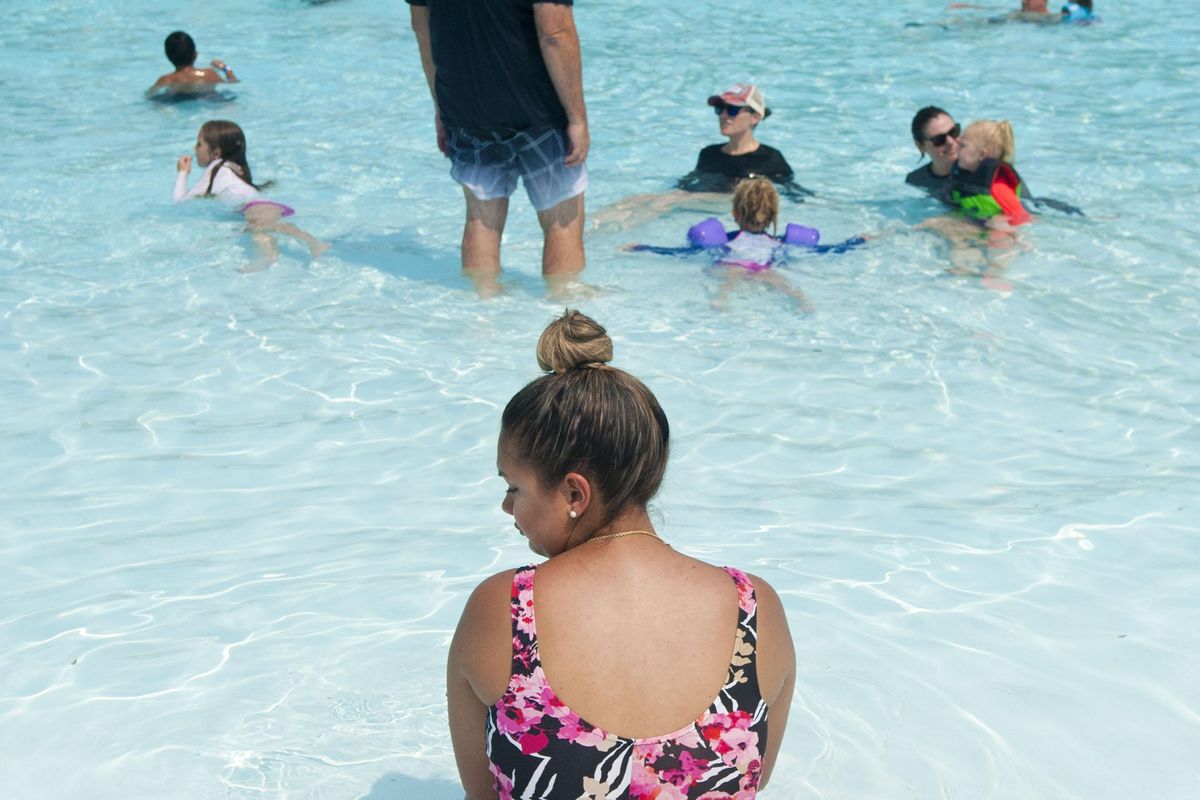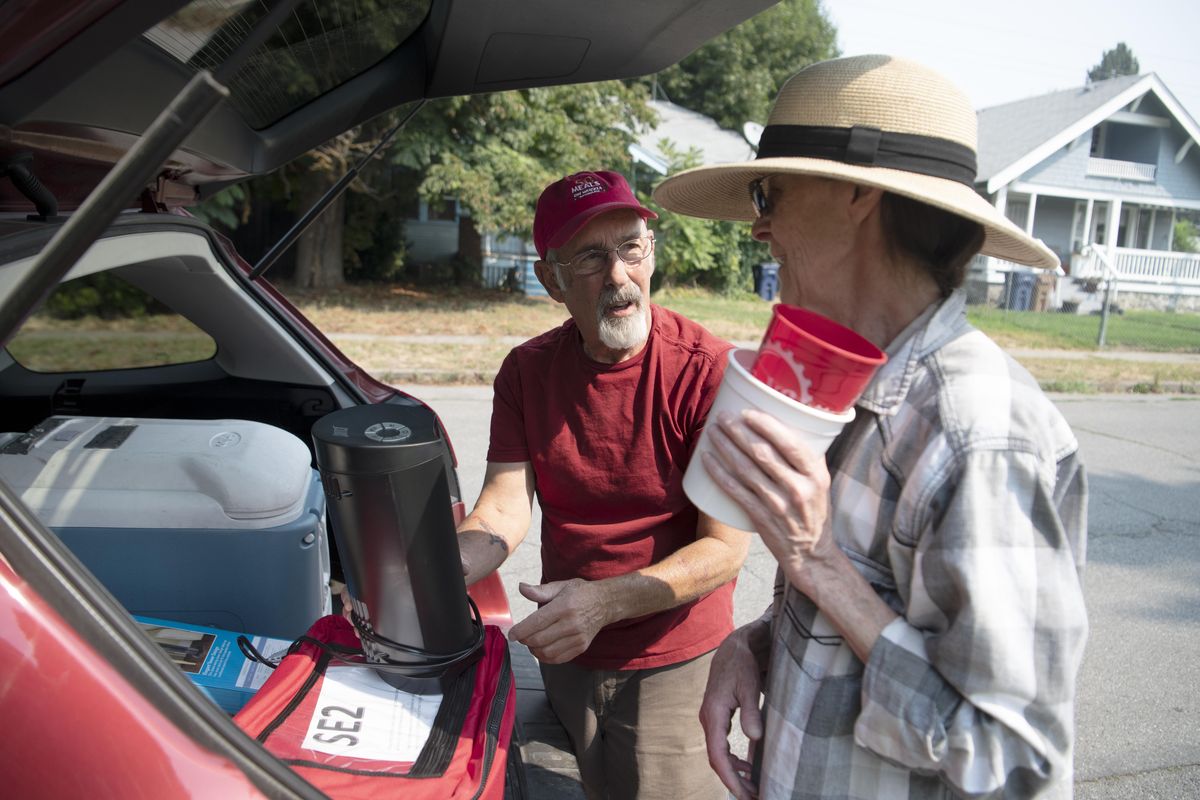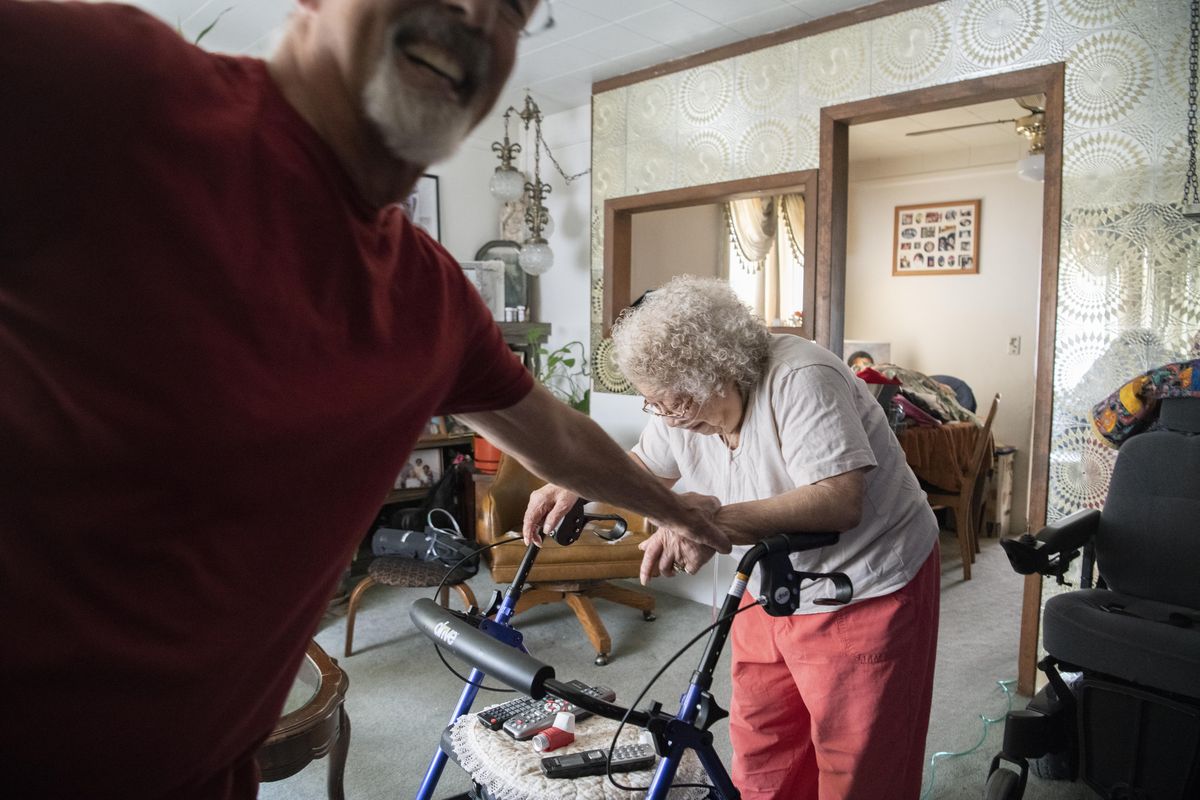The Business of Cool: How local businesses, organizations help Spokane cope when temperatures crack 100
Meals on Wheels volunteer Howard Karnovsky, left, asks MOW client Theresa Press if she needs a fan to keep cool at her home in East Central Friday, Aug. 10, 2018. The MOW volunteers make a point of checking on their clients, especially in dangerously hot and cold weather. (Jesse Tinsley / The Spokesman-Review)Buy a print of this photo
Just before the heat of the day set in, Meals on Wheels delivery driver Howard Kovarsky pulled up beside a small house in one of Spokane’s East Central neighborhoods. Beside a cooler full of hot meals in the back of his Subaru Outback sat a different kind of delivery: several types of fans, destined for elderly Spokane residents who may not have efficient air conditioning or a way to escape this week’s near-record-breaking temperatures.
Temperatures soared to 103 degrees Thursday, tying for the fourth-hottest August day in Spokane’s history, according to a National Weather Service Spokane tweet. Temperatures stayed in the hundreds Friday afternoon and officials asked Spokane-area residents to stay indoors due to the heat wave, as well as smoky conditions caused by wildfires around the West.
On days like these, the city adjusts. Residents spend less time outside, retreating to shade and air conditioning to keep from overheating. But for the folks who ensure that the supply of cool continues, work begins when the temperatures start to rise.
For Meals on Wheels, that means looking out for the city’s more vulnerable residents.
Kovarsky delivered four fans Friday, the first going to Theresa Press, who was feeding wild birds in a sunhat and sunglasses in her front yard when he arrived. Press said a family member repaired her air conditioner, a small unit in the back of the house, just before the hot weather hit. Her pet Cockatoo appreciates the heat more than she does, she said, but the fans have helped.
“I’m doing good because they’ve made sure of it,” she said. “They’ve brought me enough fans to cool off the world.”
Hank Reitz, a Vietnam veteran, said he’s had to stay inside due to the weather, but he’s been using the fans Meals for Wheels brought him and keeping the air conditioning in his apartment complex on all the time.
“I won’t go outside for a cigarette – it’s just too hot,” he said.
Kovarsky retired from the Washington State Department of Services for the Blind several years ago. He now fosters cats for the animal shelter Partners for Pets in addition to volunteering for Meals on Wheels.
He said delivering meals and other necessities is a good match for him because he loves spending time with others and it can make an immediate difference in someone’s life.
The executive director of the Meals on Wheels downtown location, Mollie Dalpae, said the organization has delivered 530 fans over the course of the summer, scores more than normal.
“We delivered more this year than we ever have in the past,” she said.
She said they serve about 600 people, about 18 percent more than last year, and they offer a variety of services depending on the season. In the summer, they mostly deliver meals and fans, but in the winter they offer blankets and sometimes deliver special donated items on or around holidays. They also deliver pet food.
Besides delivering fans, the program also has a cooling center available. It is located in the Mid-City Senior Center, which is open from 7 a.m. to 3 p.m.
Guardians of the grid
For power companies, a surge in temperature invariably means a surge in demand for electricity.
Air conditioners are some of the most energy-hungry appliances to be found in either residential or office settings, and running citywide, they push power demand to peak levels on the hottest days of the year. Power companies must plan for such days, even when they occur only a few times a year, and have extra capacity to meet demand.
“Extreme weather events like this impact the electric grid as a whole,” said David Vowels, corporate communications manager with Avista, who explained the grid is not a one-way street – power can be routed from areas of lower demand to places where it is peaking. “Operators and engineers examine the demand” and redistribute accordingly, Vowels said.
Improved weather forecasting also allows power companies to plan ahead, lining up alternative power sources that can be called upon as needed, he said.
But on really hot days, there’s more than just the increase in demand to contend with. Transmission lines carry power, but their capacity is reduced by heat. And with more power flowing through them, the lines themselves heat up.
“Power lines and substations can’t cool down like they would in winter,” Vowels said.
Some of that strain can be taken off by redistributing power flow to other lines. But Vowels said customers could also help ease demand – and save on their power bills – by being conscientious about their use of electricity.
“Avista customers can help by running appliances at not peak hours,” such as mid- to late afternoon, he said.
Keeping up with demand
Like Avista, AC installers do a clipping trade on hot days. For Randy Hastings, owner and president of R&R Heating and Air Conditioning, the challenge is keeping up with demand.
“Our biggest issue is a shortage of manpower,” he said.
With 200 to 300 calls a day coming in the past few days, his crew has been running constantly. But employees require training – sometimes a couple of years of training to become skilled in the work – and flushing out a long-term workforce can be a challenge.
“I have around 100 employees right now,” he said. “I’d put another 100 to work if I could find them.”
With installs scheduled two to three weeks out, and maintenance calls coming in hard and fast, relief for malfunctioning AC units may not be immediate. To head off potential problems, Hastings had advice similar to Avista’s: Don’t run units 24-7, particularly through the hottest parts of the day.
“It’s the same as if you were to run your car for six days straight,” said Hastings. “If you don’t let up, you’re going to have performance issues.”
The problem is worse on particularly hot days.
“Our design temperature for Spokane is 90 degrees,” Hastings said. “When it gets to 106, your unit is going to be over-maxed.” AC units can’t keep up, and even running, may not be able to cool a home much below the mid- to high 70s.
There are commonsense steps homeowners can take to both reduce strain on their appliances and reduce pull on the power grid.
“First of all, you can just resolve to be a little warmer” and adjust habits accordingly, he said.
Time of day also makes a big difference. “Let the unit run through the night, because it’s not going to keep up on afternoons like this,” he said. A lot of that cooler night air can be kept in-doors as long as a home remains sealed, he said.
Bathroom exhaust fans can come in handy, as well, by drawing warmer air from the ceilings and shuttling it outside.
Business on ice
The Frosty Ice factory in north Spokane might well be the coolest venue in Spokane.
Packed with bagged ice, pallets stacked three-high line up over a space of some 12,000 square feet, the air around them frigid. That ice will find its way to commercial locations like grocery stores and gas stations, and from there to coolers, kiddy pools and freezers all around the city.
So the hot weather should mean good business for the city’s icemen, right?
Not so much, said co-owner Ron Plummer.
“I was just talking to my delivery guys, and we’re already done delivering for the day,” he said early Friday afternoon. “When it’s really hot, people don’t go out, they don’t do things outside.”
The best temperatures for folks in the ice business? Mid-80s, said Plummer.
Still, heat is a consideration. With cold, the primary value of his product – and that cold dependent on constant refrigeration of the storage facility – power is a significant cost of business on even mild days. On particularly hot days, it’s a considerable expense, Plummer said.
That’s a far cry from the early days of the 110-year-old company’s founding, when ice was cut in blocks from area lakes and packed with sawdust into shady storage, to be chipped out bit by bit over the course of a summer.
“That was a long, long time ago,” Plummer said, “when the lakes were pristine.”








